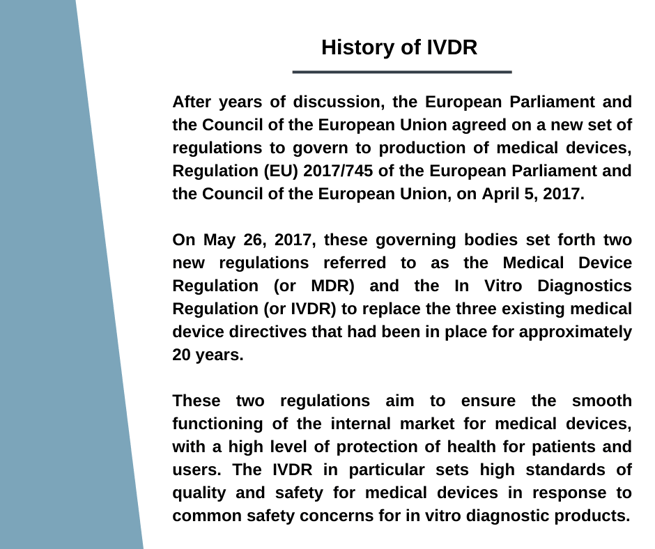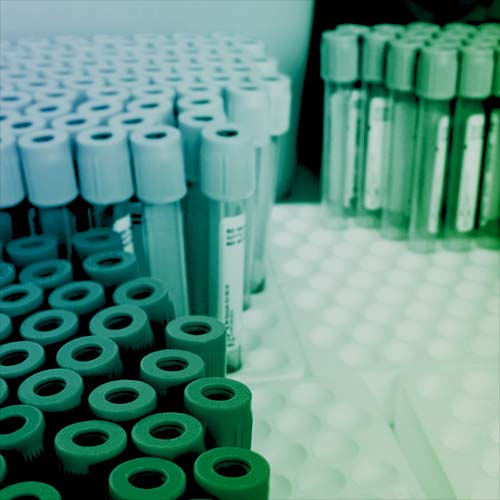Is your company as far along as it needs to be?
The In Vitro Diagnostics Regulation, or the IVDR, was created to ensure a greater level of patient protection and regulation around the creation of in vitro diagnostic devices (or IVDs). The IVDR will replace the legacy In Vitro Diagnostic Directive (IVDD) and should ensure a greater level of patient protection and provide rules and regulations that are more effectively implemented.
The manufacturers of these devices are well aware of the IVDR that will soon take effect. Most of these manufacturers are already taking the necessary steps to prepare to comply with this new regulation, but are they as far along in their preparations as they should be?
IVDR Meaning and Purpose
When comparing the In Vitro Diagnostics Directive (IVDD) and the new In Vitro Diagnostics Regulation (IVDR), the IVDR aims to improve the quality and safety of IVD devices and strengthens the transparency of information and traceability of devices.
The IVDR goes one step further and provides much more guidance on how to comply with these requirements. The IVDR’s additional definitions make regulatory requirements less open to interpretation and help provide a transparent and sustainable regulatory framework.
The certification is expected to be very challenging. Under the In Vitro Diagnostic Directive (IVDD), approximately 80% of IVDs currently on the EU market had been manufacturer self-certified for conformity without the involvement of a notified body. As of May 26, 2022, a new classification system will be in place for IVDs, and a greater number of IVDs will require a Notified Body (NB) for review and certification.
There are no grandfathering provisions for moderate and high-risk devices, meaning companies will have to have their devices certified by May 27, 2022, to be able to distribute the products in the EU.
If IVD companies intend to manufacture and distribute products that are considered moderate or high-risk (Class B, C, D per Annex VIII) under the IVDR, they should have already taken numerous steps toward compliance, as we are already over 60% of the way into the deadline.

Seeing that there is much work to be done and numerous obstacles in the way of achieving Notified Body certification for the IVDR, it is important to accelerate the efforts towards certification.
Challenges to Meeting IVDR Requirements
Regardless of where manufacturers are in their IVDR compliance efforts, there is a good chance that there are several challenges still ahead that could potentially jeopardize their ability to meet the certification deadline of May 27, 2022.
Here are some of the challenges to be aware of to ensure that there are appropriate resources for the certification plan:
- There are only four Notified Bodies designated under the IVDR. To provide some context, there are fifteen Notified Bodies designated under the EU MDR. This decreasing Notified Body, or NB, capacity is concerning for the manufacturers who have not received certification for their products or have established a relationship with an NB. The major reason for this decrease in Notified Bodies seems to be that the workload expectations on the NBs have significantly increased, forcing many NBs to withdraw from the designation process. It seems unlikely that there will be many more NBs joining. Along with the delays caused by the COVID-19 pandemic, the paucity of NBs could lead to significant bottlenecks in the product certification process, especially as the deadline approaches.
- The IVDR has vastly expanded the scope of which products fall under Class B, C, and D Devices and therefore require third party certification. These products now include single use IVDs, genetic tests, and companion diagnostics (CDx). Some estimates suggest that under the legacy IVDD, under 20% of IVD products needed third party certification, while under the new IVDR, over 80% of IVD products will now need third party certification.
- Many manufacturers don’t have access to clinical data for existing products, making an especially difficult challenge for legacy data/IVD devices. Most IVD device companies do not have their technical documentation in shape for the IVDR.
- For each Class B, C, and D device companies will need to implement an IVDR compliant QMS for each product, which involves providing documentation around a number of performance plans, reports, and information organization.
- The Quality Management System (QMS) of the company will need to be audited by an IVDR designated NB. Companies can then expect ongoing, unannounced audits of the company’s post-market surveillance about once per year.
- For those manufacturers who are marketing products that are new to NB audits and certifications, they will be wading into some unchartered waters. These manufacturers will include makers of genetic tests, companion diagnostics (CDx), software related devices, and single use IVDs. It would seem prudent for these companies to engage with a designated NB sooner rather than later in order to ensure they become familiar with both the certification process and working with a 3rd party (NB).
- Products already certified by a Notified Body may be placed on the market until May 25, 2024, under some conditions, and if the manufacturer fulfills the specific prerequisite requirements drawn in the IVDR.
- Among the many issues created by the pandemic is a slowdown in production due to quarantine periods and the shifting of resources to support projects related to development of test systems, respirators, ventilators, therapeutics, and vaccines aimed at combating the virus. These issues have contributed to slowing or even halting the progress being made towards IVDR certification. The deadline for IVDR certification hasn’t been moved, and no plans to do so have been announced. Many companies are now behind and lacking the in-house resources needed to ensure they meet the 2022 deadline.
That’s where EG Life Sciences can help. We’re well-equipped to support you and your company as you prepare to comply with the IVDR.

